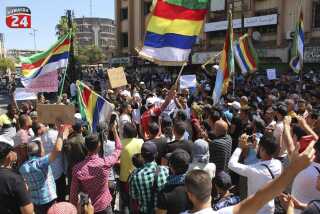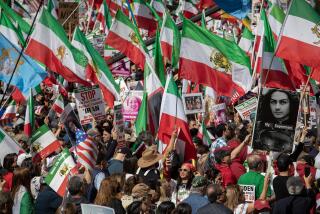Kadafi’s fate bolsters Syria protesters; 24 reported killed
Reporting from Beirut — Inspired by the demise of Libya’s Moammar Kadafi, thousands of antigovernment protesters took to the streets of Syria on Friday despite tight security to demand the ouster of President Bashar Assad.
“The news about Kadafi gave us a renewed resolve,” said an anti-Assad activist in the beleaguered neighborhood of Bab Amro in the city of Homs. “It gave us a big boost of morale,” said the activist, who was reached via Skype and asked to be identified only as Shadi out of fear of reprisal.
Syrian protesters’ invoking of the Libyan experience was perhaps the most dramatic example of how the death of Kadafi rippled across the region. Amateur video images of the ousted Libyan leader’s last moments, along with photos of his dead body, were being aired over and over on Arabic-language television stations.
On Friday, Syrian security forces killed at least 24 people, including 19 in Homs, according to the Local Coordination Committees of Syria, an anti-Assad coalition. The group issued a statement extolling Libyans’ struggle and drawing parallels with Syria.
“We, as participants in a similar battle for freedom, congratulate the Libyan people’s great victory,” the group said. “There is no turning back from the demands for freedom.”
The official Syrian news agency, SANA, denied the reports of civilians having been killed by government forces and said “armed terrorist groups” had killed a soldier and two civilians in Homs and Hama.
On Thursday, the Syrian semiofficial news channel Addounia initially denied the news that Kadafi had been killed, calling the reports “fabrications.”
Friday protests, after midday prayers, have become a weekly occurrence in Syria since major demonstrations began in March. Activists say brutal government repression has also become routine.
Along with the peaceful protests, some Assad opponents have taken up arms against the government. But the size of the armed opposition remains unclear. The government says armed groups, operating under a “foreign agenda” — probably a coded reference to Washington and its regional allies — are stoking the unrest.
Social media sites associated with the Syrian protest movement made frequent references to the death of Kadafi, who was killed in the Libyan city of Surt.
“Kadafi’s capture and death came at a good moment for the Syrians,” said Mansour, an expatriate Syrian artist in Beirut who says he fled his homeland, fearing arrest.
“Morale was low. This is a boost for the spirit of Syrian protesters,” said Mansour, who asked that his surname be withheld for security reasons.
A banner appearing in Homs and elsewhere, referring to the long neck of Assad, declared: “Kadafi is gone. Time is up for the giraffe.” In Arabic, the slogan works as a couplet, with Kadafi’s name rhyming with the word for giraffe.
Another banner in southern Syria warned Assad that Kadafi’s end was “the tyrant’s fate.”
By some accounts, protesters Friday faced beefed-up security, possibly a sign the Syrian government anticipated that Kadafi’s death would embolden its opponents. In Homs’ Baba Amro district, witnesses spoke of fire from machine guns, antiaircraft weapons and armored vehicles, including tanks.
Still, protesters came out in many places, activists said, including the suburbs of Damascus, the capital.
Experts cautioned against drawing comparisons between Libya and Syria. The mercurial Kadafi was sui generis, ruling according to his whim and seeming to make a point of alienating fellow Arab leaders, along with other world figures.
In the end, the eccentric Kadafi had no reliable powerful foreign allies outside Africa. Assad, by contrast, can count on Iran and Russia, among other foreign benefactors.
Thinly populated Libya, though rich in oil, does not have the geopolitical significance of Syria, which is situated in the heart of the volatile Middle East. Kadafi was long unpopular among Libya’s merchant class, while Assad has considerable business backing, along with the support of various minority groups. The Syrian military is a formidable force. Kadafi, though he assumed the rank of colonel, distrusted military officers who were not part of his inner circle.
Still, the brutal video of Kadafi’s final reckoning cannot have escaped notice in Damascus and other capitals where autocratic regimes have long held a grip on power.
The Assad family, in fact, has ruled Syria almost as long as Kadafi reigned in Libya.
Hafez Assad, a former Syrian air force officer, assumed power in 1970, a year after Kadafi led a bloodless coup against the Libyan monarchy. He died in 2000 and his son, Bashar, a physician, assumed power.
Marrouch is a special correspondent.
More to Read
Sign up for Essential California
The most important California stories and recommendations in your inbox every morning.
You may occasionally receive promotional content from the Los Angeles Times.










